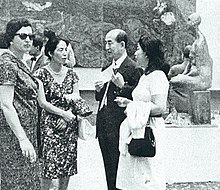Hamaguchi Yozo
Hamaguchi Yōzō ( Japanese 浜 口 陽 三 ; born April 5, 1909 in Wakayama Prefecture ; died December 26, 2000 ) was a Japanese graphic artist during the Shōwa period .
life and work
Hamaguchi moved to Chōshi in Chiba Prefecture at the age of six , where his family has been making soy sauce under the name Yamasa for many generations . He attended Keika Middle School in Tōkyō and then began training in painting under Kobayashi Mano ( 小林 萬 吾 ; 1870-1947) and learned sculpture under Tatehata Daimu ( 建 畠 大 夢 ; 1880-1942).
From 1927 Hamaguchi attended the Tōkyō Art Academy (the forerunner of today's Art School ), but left it in 1930 and went to France. There he painted oil paintings and exhibited in the Salon d'Automne, Salon des Indépendants and Salon des Tuieries. In 1937 he took part in the founding of the Japanese "Association of Free Artists" ( 自由 美術 家 協会 , Jiyū bijutsuka kyōkai ), in 1939 he returned to Japan. During his stay in France, Hamaguchi not only painted oil paintings, but also dealt with watercolor painting and experimented with printing techniques. After the Pacific War he devoted himself exclusively to printing technology.
In 1953 Hamaguchi returned to France and took up permanent residence there. He developed a printing technique with copper plates that made it possible to reproduce intermediate tones and colors. His prints, which are detailed and aesthetically pleasing, have won a number of prizes, including the National Museum of Modern Art Prize at the first Tokyo International Print Biennale in 1957 and a prize at the fourth São Paulo Biennale in the same year , and a Grand Prize at the fourth Ljubljana International Biennale in 1661.
His well-known images include the "Roofs of Paris" ( パ リ の 屋 根 , Pari no yane ), "Blue glasses" ( 青 ガ ラ ス , Aoi garasu ), "Four cherries" ( 四 つ の さ く ら ん ぼ , Yotsu no sakurambo ), "Pumpkin" ( 西瓜 , Suika ), His wife Minami Keiko ( 南 桂子 ; 1911–2004) was also a graphic artist.
In 1998 the Yamasa Corporation opened a museum in Tōkyō with around 60 works by Hamaguchi.
literature
- Suzuki, Toshihiko (Ed.): Hamaguchi Yōzō. In: Nihon daihyakka zensho (Denshibukku-han), Shogakukan, 1996.
- Tazawa Yutaka: Hamaguchi Yozo. In: Biographical Dictionary of Japanese Art. Kodansha International, 1981. ISBN 0-87011-488-3 .
Web links
| personal data | |
|---|---|
| SURNAME | Hamaguchi, Yozo |
| ALTERNATIVE NAMES | 浜 口 陽 三 (Japanese) |
| BRIEF DESCRIPTION | Japanese painter |
| DATE OF BIRTH | April 5, 1909 |
| PLACE OF BIRTH | Wakayama Prefecture |
| DATE OF DEATH | December 26, 2000 |
